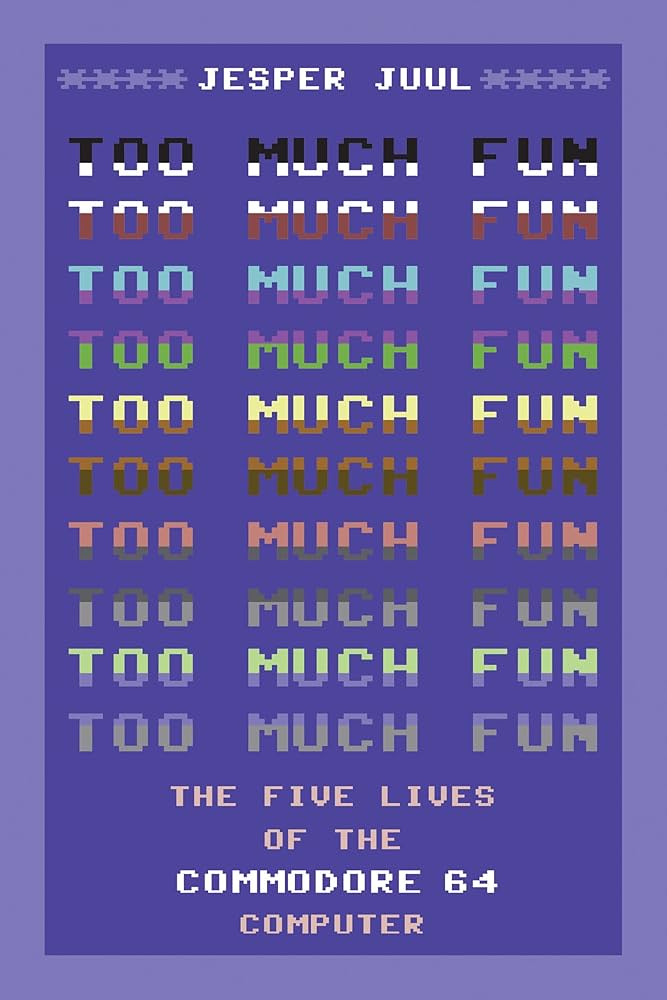Vor ein paar Tagen ist meine Rezension zu Jesper Juuls Buch »Too Much Fun. The Five Lives of the Commodore 64« auf dem Portal H-Soz-Kult erschienen.
 Unten angehängt findet sich eine englische Übersetzung der Besprechung:
Unten angehängt findet sich eine englische Übersetzung der Besprechung:
A Device for Subversive Computing
Stefan Höltgen
Until 2022, when the Raspberry Pi reached sales of 45 million units, the Commodore 64 was the best-selling computer platform of any manufacturer. A total of 37 million units of the 8-bit home computer, first released in 1982, are said to have been manufactured and sold until its production ceased in 1996. This made the C64, as it was commonly called, a highly influential microcomputer in many respects – software companies (especially for computer games), computer peripheral manufacturers, book and magazine publishers all benefited from it, but also schools, where the inexpensive computer was used in computer science classes, hobbyists who used it to learn programming, and artists who used the system’s graphics and sound capabilities as a tool for digital art production. The technological and cultural impact of the C64 continues to be researched to this day, and the system still boasts a large number of active users and hardware and software releases, even more than 40 years after its release.
This makes Jesper Juul’s entirely correct observation that the C64 receives only marginal mention in the historiography of computers and computer games all the more surprising. For Paul Ceruzzi, the author of the influential „History of Modern Computing,“ home computers like the C64 are merely marginal phenomena that appear to be of economic interest at best. Ceruzzi’s historiography is based on a popular teleological narrative model of the history of technology, according to which computer history has been heading towards one point from the very beginning: for Ceruzzi, this point is networking. Other historiographers, such as Steven Levy in his book „Hackers“ (1984) or the popular film „Pirates of the Silicon Valley“ (1999), see computer history as an echo of an eschatological event – often triggered by geniuses/engineers and their inventions. The latter two are also cited by Juul as typical examples of computer history accounts in which the Commodore 64 (and other home computers of its time) play no role. In his monograph „TOO MUCH FUN. The Five Lives of the Commodore 64 Computer,“ published in autumn 2024 in the Platform Studies series, he attempts to identify the reasons for this omission—and at the same time to get to the bottom of the phenomenon of the lasting and enduring enthusiasm that the C64 continues to arouse to this day: „The history of the C64 can similarly teach us more about the history of computing and video games. […] One goal has been to write a C64 history that includes many different relationships to the C64, from users to hardware designers to developers and product managers.“ (30f.)
Juul marks the history of the Commodore 64 in stages, each of which has been sublimated into different imaginaries of the computer and computing on the C64. By „imaginaries,“ Juul means that technologies, between their newness and their obsoleteness, go through different stages in which they acquire different meanings for their users and culture. Juul envisions five imaginaries for the C64: 1. the C64 as an easy-to-program BASIC computer for family, business, and education; 2. the C64 as an arcade game machine replacement; 3. the C64 as a platform that, beyond its ‚purposes‘ (i.e., predefined technical capabilities), was used by hackers and programming virtuosos in the demo scene; 4. the refreshed C64, which was intended to compete with the demands and capabilities of subsequent computer generations. and finally 5. the C64, which decades after its end of sales has become a style icon, which is considered an archetype for the home computer era and is now being resurrected as an emulation.
Following this division, the book is divided into five major chapters, in which Juul derives and justifies the significance of each imaginary in detail. He draws on archival materials (books, magazines, computer games) as well as interviews with C64 developers and software titles (primarily games and demos) for the platform, and, not least, draws on memories of his own time as a C64 hacker to authentically recreate the scenes of the time, their protagonists, and practices. The breadth and depth with which the author presents the platform are astonishing. Flanked by supplements on his homepage, which includes emulations, films, and code snippets, Juul provides in-depth insights into C64 programming in BASIC and assembly language, presents methods used to cheat, crack, and copy computer games, demonstrates hacks that exploit certain glitches in the C64’s hardware for graphic effects beyond the capabilities described and intended by the developers, and explains numerous idiosyncrasies of the platform with the combined knowledge of a game researcher and technology expert. Those less technically savvy can quickly find definitions by consulting a comprehensive glossary in the appendix.
Juul considers the fact that the C64 was recognized and used as a gaming computer very early on, a fact that was then vigorously promoted by the developer, Commodore, to be one of the main reasons for the platform’s invisibility in historiography: The system would have provided too much fun to be considered a serious computer at a time when computer companies wanted to open up large markets and computer games were in the crossfire of conservative media criticism and pedagogy. This even led to two of the ‚players‘ always mentioned centrally in historiographies, IBM and Apple, suppressing the impression that their computers were suitable for gaming for a long time – for example, by requiring third-party developers to expand the graphics and sound capabilities of the Macintosh and IBM PC systems in order to attract game developers.
In contrast, the Commodore 64 and the other 8-bit home computers were truly revolutionary. Juul presents the C64, which was initially seen as the heir to arcade games but then quickly transcended their technologies, aesthetics, and gameplay mechanics, as a pioneer of new computer games. In Europe, where, according to Juul, games with technical tricks and rather unusual, surreal aesthetics were successful for the C64, and in the USA, where simulation games were more likely to appear and classic heroic themes were integrated into games, the C64 established itself as a „transatlantic platform“ (cf. 71) and an important starting point for new game concepts. In the historiography of computer games, however, this significance is often overshadowed by narratives of upheaval surrounding the video game crash in the early 1980s and the release of Nintendo’s NES. However, Juul uses various game titles to demonstrate in detail the precise influence that home computers like the C64 have had on the development of games up to the present day.
This is due not least to the emergence of the cracker and pirate scene. Games released for home computers rarely spread through sales of originals, as Juul concludes from a comparison of sales charts with favorite game charts. Children and teenagers, the core group of C64 owners, much more frequently resorted to illegal copies. To create these, copy protection mechanisms had to be circumvented, which not only became a kind of sport for the crackers but also led to the emergence of the demo scene. Cracked games were often preceded by intro sequences in which the crackers demonstrated their mastery of programming techniques. This scene formation continues to this day, and the C64, due to its style and technical limitations, is still considered a popular democoding platform.
Juul’s analyses accurately describe the development of the C64, which has never changed significantly since its release. (This should be reconsidered in light of multiple kernel revisions and hardware redesigns.) They demonstrate the changes in meaning media technologies experience over the period of their use. Close contact with the medium itself (Juul repeatedly invites users to experiment with programming and gaming), reveals a different media history than the one (rarely) revealed in historiography. The added value of the hacker hands-on imperative applies once again when it comes to the reenactment of computer history. It allows for a continually fresh perspective on the platform’s archives—in this case, the C64—and demonstrates that computing is, after all, a thing of the present, even when it takes place on historical systems. In this regard, Juul’s book can serve as a manual for understanding the platform’s imaginaries.
Jesper Juul, TOO MUCH FUN, The Five Lives of the Commodore 64 Computer, Series: Platform Studies 15, Cambridge, MIT Press, 2024, ISBN: 9780262549516, US$30.00




